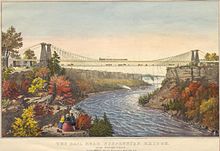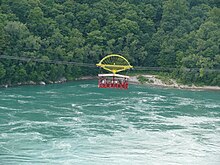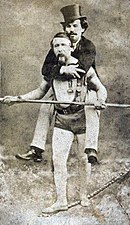Niagara Falls
Submerged in the river in the lower valley, hidden from view, is the Queenston Formation (Upper Ordovician), which is composed of shales and fine sandstones.
[8][17][18] In the 1870s, sightseers had limited access to Niagara Falls and often had to pay for a glimpse, and industrialization threatened to carve up Goat Island to further expand commercial development.
[23] Preservationists' efforts were rewarded on April 30, 1885, when Governor David B. Hill signed legislation creating the Niagara Reservation, New York's first state park.
They planned a park with scenic roadways, paths and a few shelters designed to protect the landscape while allowing large numbers of visitors to enjoy the falls.
In June 1969, a temporary rock and earth dam was constructed, completely diverting the Niagara River from American Falls for several months.
A plan to remove the huge mound of talus deposited in 1954 was abandoned owing to cost,[32] and in November 1969, the temporary dam was dynamited, restoring flow to American Falls.
Commercial interests have continued to encroach on the land surrounding the state park, including the construction of several tall buildings (most of them hotels) on the Canadian side.
[38] According to Iroquoian scholar Bruce Trigger, Niagara is derived from the name given to a branch of the local native Neutral Confederacy, who are described as the Niagagarega people on several late-17th-century French maps of the area.
The Frenchman Samuel de Champlain visited the area as early as 1604 during his exploration of what is now Canada, and members of his party reported to him the spectacular waterfalls, which he described in his journals.
[49] In 1825, British explorer John Franklin visited the falls while passing through New York en route to Cumberland House as part of his second Arctic expedition, calling them "so justly celebrated as the first in the world for grandeur".
[56] Pattinson made other photographs of Horseshoe Falls; these were then transferred to engravings to illustrate Noël Marie Paymal Lerebours' Excursions Daguerriennes (Paris, 1841–1864).
[58] The two men on the scow were rescued, but the vessel remained trapped on rocks in the river, and is still visible there in a deteriorated state, although its position shifted by 50 meters (160 ft) during a storm on October 31, 2019.
Before the late 20th century, the northeastern end of Horseshoe Falls was in the United States, flowing around the Terrapin Rocks, which were once connected to Goat Island by a series of bridges.
[1] In the early 1980s, the U.S. Army Corps of Engineers filled in more land and built diversion dams and retaining walls to force the water away from Terrapin Point.
[73] Augustus and Peter Porter purchased this area and all of American Falls in 1805 from the New York state government, and enlarged the original canal to provide hydraulic power for their gristmill and tannery.
The water fell 26 metres (86 ft) and generated direct current electricity, which ran the machinery of local mills and lit up some of the village streets.
By 1896, financing from moguls including J. P. Morgan, John Jacob Astor IV, and the Vanderbilts had fueled the construction of giant underground conduits leading to turbines generating upwards of 75 megawatts (100,000 hp), sent as far as Buffalo, 32 km (20 mi) away.
The Government of Ontario eventually brought power transmission operations under public control in 1906, distributing Niagara's energy to various parts of the Canadian province.
The water then passes through hydroelectric turbines that supply power to nearby areas of Canada and the United States before returning to the river well past the falls.
Local hotel owners acquired a former Lake Erie freighter, loaded it with animals and effigies of people, towed it to a spot above the falls and let it plunge over the brink.
[86] On October 24, 1901, 63-year-old Michigan school teacher Annie Edson Taylor became the first person to go over the falls in a barrel as a publicity stunt; she survived, bleeding, but otherwise unharmed.
[92] Minutes later, Woodward was plucked from the roiling plunge pool beneath Horseshoe Falls after grabbing a life ring thrown to him by the crew of the Maid of the Mist boat.
[97][98] In August 1985, Steve Trotter, an aspiring stuntman from Rhode Island, became the youngest person ever (age 22) and the first American in 25 years to go over the falls in a barrel.
Authorities subsequently began to search the lower Niagara River basin, where the man was found alive but injured sitting on the rocks at the water's edge.
[122] On June 15, 2012, high wire artist Nik Wallenda became the first person to walk across the falls area in 116 years, after receiving special permission from both governments.
Also on Goat Island are the Three Sisters Islands, the Power Portal where a statue of Nikola Tesla (the inventor whose patents for the AC induction motor and other devices for AC power transmission helped make the harnessing of the falls possible) can be seen, and a walking path that enables views of the rapids, the Niagara River, the gorge, and all of the falls.
[139] Although The New York Times had long before described attempting to tour the falls as "bent on suicide"[38] and despite a number of fatal crashes, the "as many as 100 eight-minute rides each day" are hard to regulate; two countries and various government agencies would have to coordinate.
[142] The falls was a featured location in the major motion picture Superman II in 1980[143] and was the subject of a popular IMAX movie, Niagara: Miracles, Myths and Magic.
[148] The Niagara Falls area features as the base camp for a German aerial invasion of the United States in the H. G. Wells novel The War in the Air.
In her despair she guides her canoe over the falls in dramatic fashion: 'Upright, within that slender boat, they saw the pale girl stand, her dark hair streaming far behind—uprais’d her desperate hand.

























